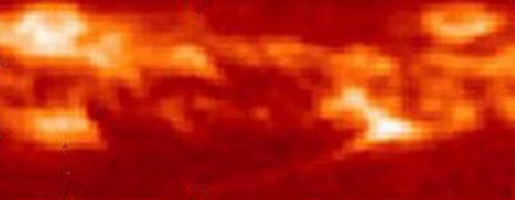 |
||
|
Infra-red
hotspots allow us to see to depths where the pressure is 8 bars.
|
||
| THE INTERIOR OF JUPITER | ||
| Jupiter is the largest planet in the Solar System (142,800 kilometres across) and has more mass than all the other planets put together (1.9 x 1027 kilogrammes). | ||
| Ideas of Jupiter's interior formulated in the early part of the 20th century describe a large rocky core with a radius of between 30,000 to 45,000 kilometres. The core was thought to be mantled by ice and frozen carbon dioxide overlain by a deep but tenuous atmosphere. | ||
| Metallic hydrogen | ||
| A better theoretical model was developed in the 1950s. It was backed up by spectroscopic (analysis of light) studies from Earth and from observations by Voyager. The new model maintained that the interior of Jupiter comprises a very large core of metallic hydrogen surrounded by a layer of liquid hydrogen. Jupiter was also demonstrated to contain helium and smaller amounts of methane and ammonia. A little water was also found. | ||
| The metallic hydrogen is in fact a liquid, but a liquid which has the conductive properties of a metal. Deep within Jupiter, under extreme pressure, hydrogen atoms are broken apart. Their electrons are freed leaving bare protons. The resulting matter is "liquid metallic hydrogen". It is not a transitional state between a liquid and a solid, but a liquid with unusual electrical characteristics. | ||
 Cross-section of Jupiter. |
||
| Even though the materials which make-up the planet are known, determining their structure under Jovian conditions has presented a major challenge. The behaviour of hydrogen and helium at very high temperatures and pressures is not well understood. It is not known at what point hydrogen becomes metallic, or what exactly happens when hydrogen and helium are mixed at different temperatures and pressures. | ||
| The outer hydrogen and helium layers are regular or molecular hydrogen and helium; the elements as they are normally encountered. They exist in a liquid phase in the interior and further out towards the surface as gas. It is thought that the transition from gaseous to liquid hydrogen occurs at 1000 kilometres below the visible surface. The temperature here is 2000 K and the pressure 5600 atmospheres (1 atmosphere = 1.03 kg cm-2) | ||
| With greater depth hydrogen becomes gradually more compressed. At about 25,000 kilometres below the surface the metallic hydrogen is encountered. The pressure here is an estimated 3 million atmospheres and it is extremely hot (11,000 K). | ||
| At the very centre of Jupiter the temperature rises to 30,000 K. It is hotter than the surface of the Sun (6050 K). The pressure at the centre of Jupiter is calculated to be 100 million atmospheres. That is 100 million times the pressure experienced on Earth at sea level. | ||
| Rocks | ||
| It had been considered that hydrogen and helium and various other gases accounted for the entire planet. But lately the idea that Jupiter has a rocky core has undergone a revival. Speculation of what this inner core is like varies considerably. It probably contains silicate rocks and iron. A typical estimate gives the core a radius of about 6000 kilometres, fairly close to the radius of the Earth. Because of the immense pressures at depth, such a small core would have ten or twenty times as much mass as the Earth. | ||
| Until recently much of what we knew about Jupiter was inferred from the most basic physical properties such as the mass, density, orbital properties, magnetic field and what little was known about its constituent materials. The results from the Galileo probe sent into Jupiter are helping to build a better understanding of how Jupiter is structured, how the planet works, and how it might have evolved. | ||
|
|
||